
Blechnaceae is a family of ferns in the order Polypodiales, with a cosmopolitan distribution. Its status as a family and the number of genera included have both varied considerably. In the Pteridophyte Phylogeny Group classification of 2016, the family has 24 genera, and excludes genera placed in the separate family Onocleaceae. The family is divided into three subfamilies, including Blechnoideae s.s. Alternatively, the entire family may be treated as the subfamily Blechnoideae s.l. of a very broadly defined family Aspleniaceae, and include genera others place in Onocleaceae.

Blechnum, known as hard fern, is a genus of ferns in the family Blechnaceae, subfamily Blechnoideae, according to the Pteridophyte Phylogeny Group classification of 2016. Two very different circumscriptions of the genus are used by different authors. In the PPG I system, based on Gasper et al. (2016), Blechnum is one of 18 genera in the subfamily Blechnoideae, and has about 30 species. Other sources use a very broadly defined Blechnum s.l., including accepting only two other genera in the subfamily. The genus then has about 250 species. In the PPG I circumscription, the genus is mostly neotropical, with a few southern African species.

Hymenophyllum nephrophyllum, the kidney fern, is a filmy fern species native to New Zealand. It commonly grows on the forest floor of open native bush. Individual kidney-shaped fronds stand about 5–10 cm tall. In hot weather they shrivel up to conserve moisture, but open up again when the wet returns. This species has very thin fronds which are only four to six cells in thickness. In the Māori language they are also called raurenga.

Cranfillia fluviatilis, synonym Blechnum fluviatile, is a fern known in the Māori language as kiwikiwi. A herbaceous plant, C. fluviatilis is a "hard fern" of the genus Cranfillia in the family Blechnaceae. It was identified by Patrick Brownsey in 1979. Other common names are star fern, creek fern, kawakawa and kiwakiwa.

Zealandia pustulata is a species of fern native to eastern Australia and New Zealand. It is commonly referred to as kangaroo fern because of its mature leaves tend to resemble the shape of a kangaroo foot. It is also referred to as hound's tongue, and as kōwaowao and pāraharaha in Māori.
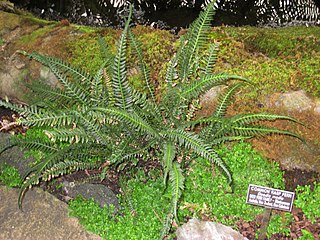
Doodia media, also known as rasp fern, is a fern species in the family Blechnaceae. The species was formally described by botanist Robert Brown in 1810. Distribution of the species includes New Zealand's North Island and the upper part of the South Island. It is also found in Australia and Lord Howe Island.
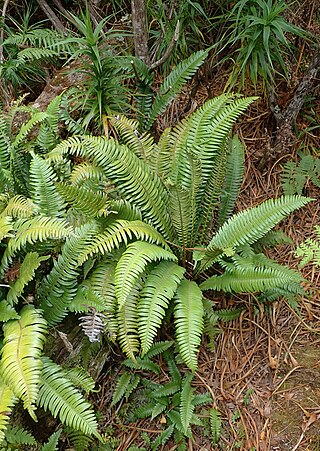
Austroblechnum durum, synonym Blechnum durum, is a species of fern in the family Blechnaceae. The fern is endemic to New Zealand.

Rumohra adiantiformis, the leather fern or leatherleaf fern, is a species of fern in the wood fern family Dryopteridaceae. It has a wide distribution, mainly in the tropical Southern Hemisphere.
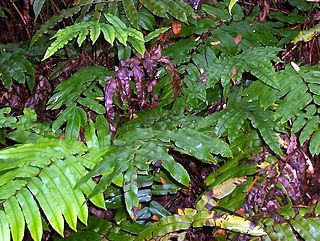
Parablechnum wattsii, synonym Blechnum wattsii, is a common terrestrial fern growing in rainforest and open forest. It is often seen near creeks in much of south eastern Australia, including Victoria, Tasmania, South Australia, New South Wales and Queensland. The specific epithet wattsii honours William Walter Watts (1856-1920). Watts was considered an authority on mosses and ferns and has more than 30 species named for him. Common names by which the species may be called are hard water fern - from its stiff leathery fronds, leech fern - as forest workers often encounter leaches while working in clusters of these ferns, hard hill fern - from the fern's habit and habitat, and red cabbage fern - from the bronze-pink colour of the young fronds resembling cooked red cabbage.

Lomaria nuda, commonly known as the fishbone waterfern, is a fern that grows up to a metre tall, and is abundant in rainforest and eucalyptus forests in eastern Australia. The species is placed in the genus Lomaria in the Pteridophyte Phylogeny Group classification of 2016, but is often retained in genus Blechnum as Blechnum nudum.
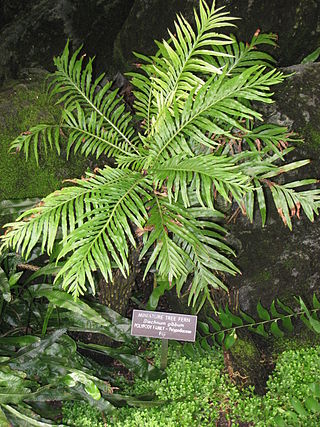
Oceaniopteris gibba, the miniature tree fern, is a tropical species of fern in the family Blechnaceae, native to New Caledonia and introduced in Fiji. It has received the Royal Horticultural Society's Award of Garden Merit.
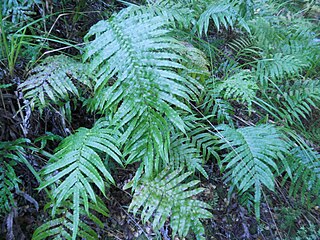
Parablechnum novae-zelandiae, synonym Blechnum novae-zelandiae, commonly known as palm-leaf fern or kiokio, is a species of fern found in New Zealand. It can often be found growing in clay soil on embankments and roadsides.

Lomaridium contiguum, synonym Blechnum contiguum, is a fern in the family Blechnaceae. The specific epithet refers to the contiguous lobes of the fronds.

Cranfillia fullagari, synonym Blechnum fullagarii, is a fern in the family Blechnaceae. The specific epithet honours James Fullagar, who collected plants on Lord Howe Island for the Royal Botanic Gardens, Melbourne.

Parablechnum howeanum, synonym Blechnum howeanum, is a fern in the family Blechnaceae. The specific epithet refers to the locality to which it is endemic.

Alsophila ferdinandii, synonym Cyathea macarthurii, is a fern in the family Cyatheaceae.
Callistopteris bauerianum, known as the large filmy fern and Bauer's bristle fern, is a fern in the family Hymenophyllaceae. The specific epithet honours the Austrian botanical artist, Frederick Lucas Bauer (1760–1826), who collected plants on Norfolk Island in 1804–1805.

Hymenophyllum howense is a fern in the family Hymenophyllaceae. The specific epithet refers to the locality of occurrence.

Parablechnum gregsonii, synonym Blechnum gregsonii, is a type of fern, mostly seen in the Illawarra and Blue Mountains areas of eastern Australia, often near waterfalls and moist gullies.

Cranfillia is a genus of ferns in the family Blechnaceae, subfamily Blechnoideae, according to the Pteridophyte Phylogeny Group classification of 2016. The genus is accepted in a 2016 classification of the family Blechnaceae, but other sources sink it into a very broadly defined Blechnum, equivalent to the whole of the PPG I subfamily.


















